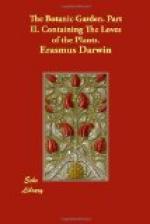In many circumstances this wind seems much to resemble the dry fog which covered most parts of Europe for many weeks in the summer of 1780, which has been supposed to have had a volcanic origin, as it succeeded the violent eruption of Mount Hecla, and its neighbourhood. From the subsidence of a white powder, it seems probable that the Harmattan has a similar origin, from the unexplored mountains of Africa. Nor is it improbable, that the epidemic coughs, which occasionally traverse immense tracts of country, may be the products of volcanic eruptions; nor impossible, that at some future time contagious miasmata may be thus emitted from subterraneous furnaces, in such abundance as to contaminate the whole atmosphere, and depopulate the earth!]
325 When stretch’d in dust her gasping panthers
lie,
And
writh’d in foamy folds her serpents die;
Indignant
Atlas mourns his leafless woods,
And
Gambia trembles for his sinking floods;
Contagion
stalks along the briny sand,
330 And Ocean rolls his sickening shoals to land.
[His sickening shoals. 330. Mr. Marsden relates, that in the island of Sumatra, during the November of 1775, the dry monsoons, or S.E. winds, continued so much longer than usual, that the large rivers became dry; and prodigious quantities of sea-fish, dead and dying, were seen floating for leagues on the sea, and driven on the beach by the tides. This was supposed to have been caused by the great evaporation, and the deficiency of fresh water rivers having rendered the sea too fast for its inhabitants. The season then became so sickly as to destroy great numbers of people, both foreigners and natives. Phil. Trans. V. LXXI. p. 384.]
—Fair
CHUNDA smiles amid the burning waste,
Her
brow unturban’d, and her zone unbrac’d;
Ten
brother-youths with light umbrella’s shade,
Or
fan with busy hands the panting maid;
335 Loose wave her locks, disclosing, as they break,
The
rising bosom and averted cheek;
[Chunda. l. 331. Chundali Borrum is the name which the natives give to this plant; it is the Hedylarum gyrans, or moving plant; its class is two brotherhoods, ten males. Its leaves are continually in spontaneous motion; some rising and others falling; and others whirling circularly by twisting their stems; this spontaneous movement of the leaves, when the air is quite still and very warm, seems to be necessary to the plant, at perpetual respiration is to animal life. A more particular account, with a good print of the Hedyfarum gyrans is given by M. Brouffonet in a paper on vegetable motions in the Histoire de l’Academie des Sciences. Ann. 1784, p. 609.




